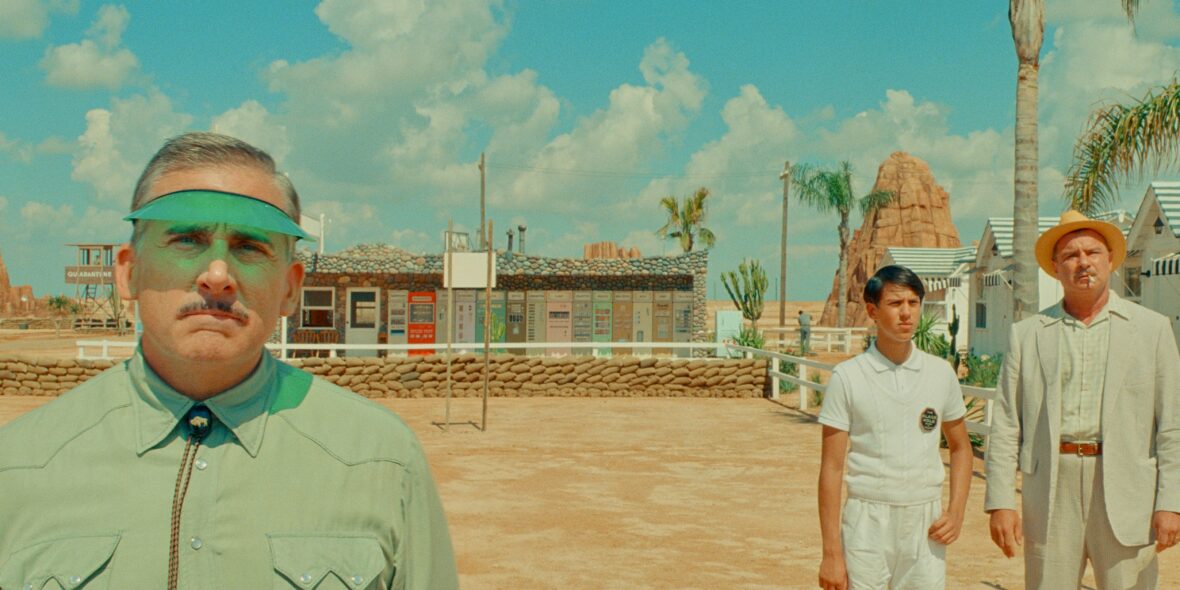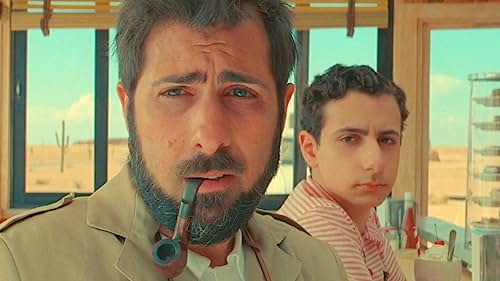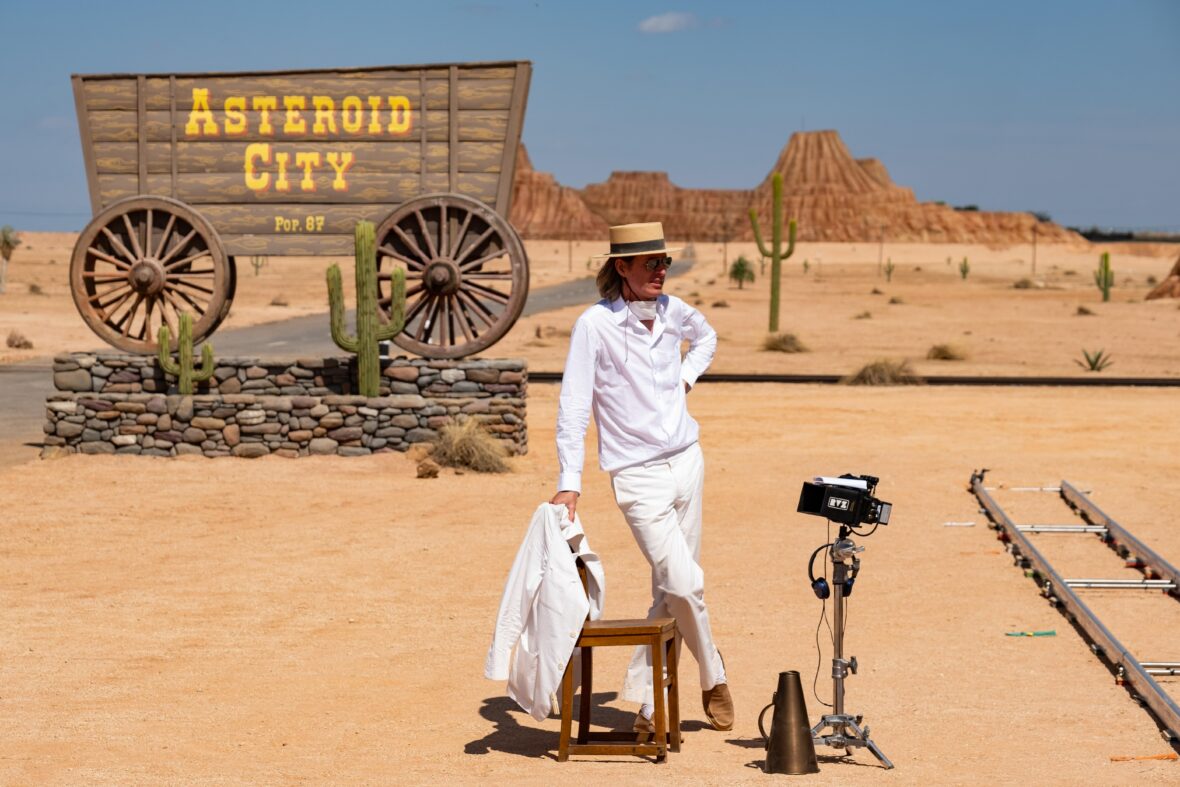
Wes Anderson’s newest film, Asteroid City, has all the seductive aesthetics, legendary faces, and endearing quirks one would expect from an exceptional director. It’s humorous and frequently sardonic, but like some of his previous movies, it has a tragic undercurrent in this Asteroid City review. A portion of the story takes place in a fictitious Southwest town in 1955, a desolate four corners housing a diner, petrol station, and motor inn. The village is dotted with palm trees and cacti, while in the distance, reddish buttes rise. When you look past the atomic cloud that is quickly growing in the sky, it appears to be a typical rest stop.
The movie, which was written by Anderson, is about mortality and desire, little-known facts and cosmic mysteries, and the narratives we create around everything that we name life in this Asteroid City review. In a studio, it begins in black and white with an unidentified television host (Bryan Cranston, looking serious and sporting a mustache).
Speaking directly into the camera while firmly enclosed by the boxy aspect ratio, he sets the tone for the evening’s entertainment, which includes a “backstage” peek into the development of a brand-new production called “Asteroid City,” which was created “expressly for this broadcast.” The playwright, Edward Norton, is then introduced by him. He gets out from behind his typewriter to stand on an empty stage and introduce the characters.
Setting the Scene

In stunning black and white and square aspect ratio, this film begins as a TV documentary set in the United States of America in the year 1955. After having seen a number of Anderson’s previous films, I wondered whether there would be voice acting. The answer to my question was both yes and no. Bryan Cranston, dressed impeccably, narrates the fake documentary, which relates the tale of the theatrical production of Carter Earp’s “Asteroid City.” Anderson and crew offer the film in stunning color, widescreen, and cinematic flair.
It’s not difficult to follow, even though it sounds like it already. The most cleverly designed and expertly performed of Anderson’s anthology/nesting multi-narrative films is his most recent feature in this Asteroid City review. The setting of Earp’s play is a remote meteor crash site in the West that serves as a kind of Space Camp.
The location is stunning both in terms of building arrangement and design—the orange hue of the desert and the cloudless blue sky provide the visual equivalent of eating a Creamsicle on a bright day—as the settings for all of Anderson’s films have a tendency to be in this Asteroid City review. Nothing about the details—not even the copy on the front of the café or the vending machine displays—is superfluous.
Shortly after the playwright’s opening words, the action begins, but it doesn’t look like a theater production at all. It appears to be a wide-screen, Wes Anderson film, one that is painstakingly detailed and aesthetically harmonious in this Asteroid City review. There isn’t a proscenium, stage, wings, or audience present.
The town is covered in a beautiful sky, while the yellow desert reaches the horizon. The characters are photographed in close-up and long view, with the camera expertly framing each scene. They arrive by bus and automobile. The color scheme is astounding, a dusty rainbow of colors. This tale appears to have been exposed to sunlight before being wrapped in translucent, yellowed plastic.
Check Out: Oppenheimer Review: a Bomb That Doesn’t Detonate
Character Introductions

This little, quiet village is holding a camp called Space Camp, where a group of bright young people are congregating. Some of their futuristic innovations, like a disintegration ray, are actually being held hostage by the U.S. government, which is depicted here in its most benevolent light by Jeffrey Wright’s General Gibson in this Asteroid City review. Every one of the bright kids has their own drama. Woodrow (Jake Ryan) is the eldest child of war photographer Augie Steenback (Jason Schwartzman), who hasn’t informed the teen or his three little girls that their mother passed away three weeks ago as a scholarship competition gets underway.
Called “Brainiac” by his devoted mother, Woodrow immediately and understandably feels a connection to fellow “Junior Stargazer” Dinah (Grace Edwards). Dinah is the daughter of movie star Midge Campbell (Scarlett Johansson), whose unwavering dedication to her craft is matched by her free-flowing melancholy in this Asteroid City review.
Other Stargazers struggle with various problems: Clifford Kellogg (Aristou Meehan), who feels compelled to urge grownups to dare him to commit foolish acts, and Ricky Cho (Ethan Josh Lee), who has a healthy mistrust of authority. Remarkably, Anderson manages to effortlessly weave characters and their peculiar characteristics into a narrative that never lets up, keeping the audience captivated for the entirety of the 105-minute film.
Also Read: Indiana Jones and the Dial of Destiny Review: A Nostalgic Triumph
Dazzling Charm

Deadpan adorable exclamations (“Gadzooks”) and geeky awkwardness (“I love gravity”) are interspersed throughout the script by Anderson and co-writer Roman Coppola. These are all complemented by the signature parade of sandals, pulled-up socks, frightening pants, and pressed shirts in this Asteroid City review. Character names give homage to the past of film (a Steenbeck, for instance, is a celluloid editing machine), but the air of smug modernity is walled in, feeling stiflingly close-lipped.
It’s difficult to know whether to laugh, shrug, or sympathize when Johansson informs Schwartzman that their characters are “two catastrophically wounded people who don’t express the depth of our pain because we don’t want to”. The statement “We’re in grief” appears somewhere like a flying saucer that has lost its desire to fly. Intentionally, I assume.
In perfect timing and humor, Schwartzman and Scarlett Johansson round out the film’s emotive center. Johansson plays two parts: that of an actor and that of a character. In the play, she plays sexy Hollywood diva Midge Campbell, who arrives in town escorted by a bodyguard and her own whiz-kid.
Although Midge and Augie first hit it off in the cafe, their romance really takes off when they are staying in separate rental cabins in this Asteroid City review. There, between windows, they turn to face one another and start conversing in that somewhat sarcastic, distinctly Anderson-screwball manner that presents a sharp, theatrical front that gradually gives way to intense emotion.
Emotional Resonance

Anderson alternates between the drama in the village and the television program on a frequent basis, progressively bringing them into dramatic, meaningful, and dynamic play with one another. Both experiences include crises, self-doubt, conflicts, assignations, and talks about life and art in this Asteroid City review. He packed a lot of information, including theatrical lore and references to movies, into one movie. The drama is set in September 1955, the same month that James Dean passed away in a different dry wasteland in the Southwest. Jones and the author reenact Brando’s infamous audition for Tennessee Williams’s “A Streetcar Named Desire.”
In Asteroid City, Anderson and co-writer Roman Coppola seem to be surrendering to instinct, which is quite evident for such a methodical director. It’s not so much in their flawless set design and exacting blocking as it is in the way they let the plot develop in this Asteroid City review. Although Earp’s play is structured into three acts, Anderson’s storytelling is looser and more poetic, giving little consideration to the desires of the characters or the traditional hero’s journey.
After all, we’re always feeling around in the dark, dreaming, and awakening; life doesn’t really work like that. Whether or not you’re a brainiac, you’re unlikely to find—or be happy with—the solutions to the universe’s greatest riddles no matter how much you search for them. So perhaps all that’s left is enjoying yourself, creating art with your group, and exploring the world with the kind of wit and spunk that Anderson loves to imbue in his young characters.
Check Out: The Idol Review: The Worst Show of the Summer
Asteroid City Review: Final Thoughts

The most intense sequence in the film is a heartbreaking backstage scene where Jones Hall confides in the character who would have played his wife if her scene hadn’t been removed. Later in the play, this same figure is present when the children bury their mother for eternity in this Asteroid City review. The pivotal moment in the film, in my opinion, is when the alien returns the asteroid and wild mayhem ensues.
Following their discussion of the most significant symbol to project onto the moon, the Junior Stargazers were inspired by Woodrow, who said, “This is our chance to be actually worthwhile.” When the time comes, Woodrow projects a heart with his initials and the initials of his new girlfriend instead of an American flag or a religious sign.
It is meant to be humorous. But truly, amid all the chaos of life, is there anything more lovely and meaningful than publicly expressing your love to a person you’ve only known for a week?
The thought of an unintentionally hilarious Wes Anderson universe is entertaining, in part because his films, with all their suffering, shattered hearts, crushed hopes, and nuclear weapons, may appear to be strangely detached from reality in this Asteroid City review. The stylistic way he arranges the globe with his highly populated cast of collaborators in his films is part of what makes them memorable and frequently surprisingly emotional.
It also represents how he navigates the confusion of the outside world. Augie serves as a reminder of the atrocities he has witnessed as he shows Midge the bald patch on his head from where he was injured by shrapnel while on assignment. It’s a symbol of his suffering, but it’s also a call for our compassion and an invitation to someone else.
More About:Movie Reviews


